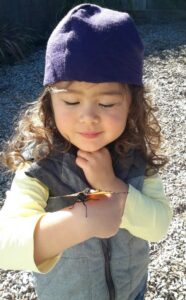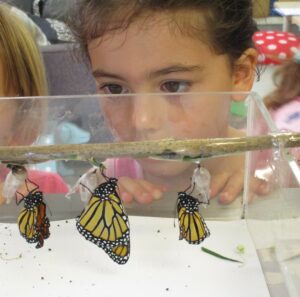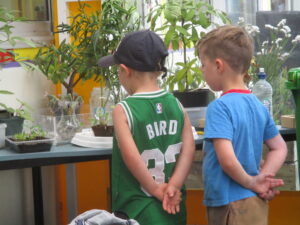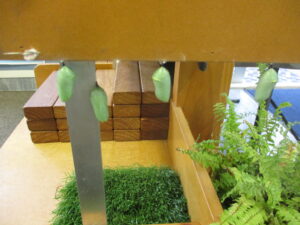
Nanaka and a butterfly.
We began our Monarch Butterfly Project at Clevedon Kindergarten in 2019, when a tamaiti brought in some caterpillars and we had to quickly find a source of food for them. We soon began to get more and more and this turned into a wonderful teaching and learning opportunity for everyone involved. Since beginning what became an annual project, we have always housed the caterpillars inside: firstly to watch and observe them go through their life cycle and secondly to protect the caterpillars from the wasps and praying mantis that seek them out and destroy them.
Raising and caring for the caterpillars and releasing the butterflies is an excellent way of teaching young children about the butterfly life cycle, food requirements, pest control and overall awareness of the world around them.
We began by making rules around the caterpillars, hence the creation our whole centre culture of care and respect and developing a wonder of nature, that we have today.
Sourcing the swan plants for food was a problem so, during the 2020 lockdown, kaiako spent time creating a wild garden in our bio cycle area and spread hundreds of swan plant pods that we had collected over the months, to germinate and grow. Other flower and shrub cuttings were added to attract butterflies and bees to our environment. Our project grew in numbers and interest each year and we learnt how to identify male and female Monarch butterflies and have been keeping tally of how many we have released into our environment.

Hands behind your back if you are going to look.
We house the butterflies near our entrance and whanau and visitors are captivated by the sight of caterpillars and chrysalises as they come in. It’s wonderful to hear tamariki reminding their parents that they have to put their hands behind their backs if they want to look!
Children have shown incredible protectiveness towards these living creatures as the caterpillars grow and change. Some caterpillars and butterflies don’t survive metamorphosis however our tamariki accept this is what happens in nature and that it is a part of life, again, reflecting our Enviroschool kaupapa and culture of respect, caring, kindness and empathy for all living things.
“Once they’ve eaten much, they turn into a chrysalis, or it could be called their home where they sleep. After, they turn into a butterfly.” – Nolan
As our wildflower garden grew (including the swan plants) Monarch butterflies visited to lay eggs. Once the caterpillars hatched, we brought them inside to nurture them, watch them grow, change and then to release them on their journey. By 2021, we had released over 400 butterflies into our environment. We also had to control the number of wasps visiting, so we made wasp traps using natural products to place around our centre to protect those caterpillars we have missed bringing inside. We also have had butterflies coming inside to lay eggs on the plants and unfortunately wasps also come inside to hunt them out.
“They do a lot of poop.” – Noah
We were fortunate to receive funding from Auckland Council’s Natural Environment Targeted Rate fund for the purchase of plants, bird feeders and other items that will attract birds, bees and butterflies to our wild garden.

Careful observation of metamorphosis.

Noticing the activity. Keeping to tikanga.
2022 has seen our project continue through the winter months, as there have been butterflies around during this time. Already there are caterpillars hatching and we will soon be bringing them inside again. Our tally this year (so far) is 317.
This project has provided countless opportunities to empower tamariki to become curious, to discover and interact with nature and allow them to learn by doing, thinking, asking questions and posing hypotheses – thereby developing inquisitive minds and to be involved and do their part in protecting the Monarch butterfly.
“It’s a caterpillar and goes into a cocoon then poof it’s a beautiful butterfly!” – Amber

The inside environment helps protect the chrysalises.